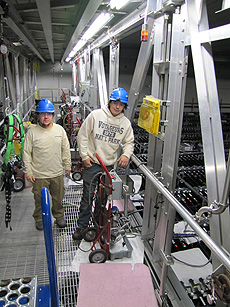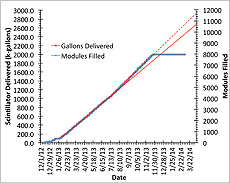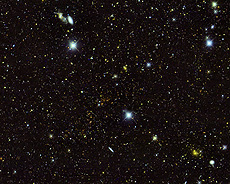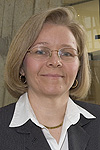Have a safe day!
Wednesday, Dec. 4
2 p.m.
Fermilab Colloquium (NOTE TIME) - One West
Speaker: Charles Ferguson, Federation of American Scientists
Title: The Japan Nuclear Crisis and Implications for the U.S. and the World
3:30 p.m.
DIRECTOR'S COFFEE BREAK - 2nd Flr X-Over
Thursday, Dec. 5
11 a.m.
Academic Lecture Series - One West
Speaker: Patrick Fox, Fermilab
Title: Principles of Direct Dark Matter Detection
2:30 p.m.
Theoretical Physics Seminar (NOTE LOCATION) - WH3NE
Speaker: Marco Farina, Cornell University
Title: Naturalness After the First Run of the LHC
3:30 p.m.
DIRECTOR'S COFFEE BREAK - 2nd Flr X-Over
Click here for NALCAL,
a weekly calendar with links to additional information.
Ongoing and upcoming conferences at Fermilab
|
|
Wednesday, Dec. 4
- Breakfast: breakfast pizza
- Breakfast: ham, egg and cheese English muffin
- Chicken fajita club sandwich
- Smart cuisine: baked pork chops
- Chicken tandoori
- California club
- Chicken carbonara
- Navy bean soup
- Texas-style chili
Wilson Hall Cafe menu |
|
Wednesday, Dec. 4
Lunch
- Mexican pork stew
- Refried beans
- Rice
- Pineapple flan
Friday, Dec. 6
Dinner
- Mussels in white wine and thyme
- Medallions of beef
- Sour cream and chive mashed potatoes
- Haricots verts
- Chocolate pots de crème
Chez Leon menu
Call x3524 to make your reservation.
|
|
Two million gallons in the NOvA detector
 |
Kyle Wood (left) and James Hoffman, both of the University of Minnesota, work to fill the 14-kiloton far detector with liquid scintillator. The crew just reached the 2-million-gallon mark, with 700,000 gallons to go. The far detector, which is being constructed in northern Minnesota, is scheduled to be completed next summer. Photo: William Miller, NOvA installation manager |
The construction of the 14-kiloton NOvA far detector in Minnesota hit a major milestone this week: Collaboration members poured the 2 millionth gallon of scintillating oil into the detector.
The NOvA detector, when completed early next year, will stand 50 feet high, 50 feet wide and span more than 200 feet. It is constructed of PVC modules, each wired with light-sensing fiber-optic cable, and will be filled with a liquid scintillator. According to Deputy Project Manager Rick Tesarek, the liquid — which emits detectable light when charged particles interact with it — is cheaper by weight than solid plastic scintillator.
Workers are constructing the NOvA far detector near Ash River in Minnesota, just south of the Canadian border. The last of 28 plastic blocks is scheduled to be completed and placed by March, with all 2.7 million gallons of liquid scintillator poured by April and the final bank of electronics installed by June. The detector is already receiving neutrino beam from Fermilab's particle accelerator complex, and the first detector modules are recording data.
—Andre Salles
 |
NOvA is on track to finish filling the detector with scintillator oil by spring. |
|
El Gordo
 |
| A splatter of red, denoting galaxies, lies at the center of this image and extends toward the lower left. This is the remnant of a cosmic collision. Eons ago, one group of galaxies plunged into another at millions of miles per hour, leaving a wreckage in its wake. The galaxy cluster El Gordo is all that remains of this raucous event. Learn more at Dark Energy Detectives. Photo: Dark Energy Survey |
|
In memoriam: Jacqueline Wilson
Fermilab retiree Jacqueline Wilson, who worked at the laboratory for more than 30 years, passed away Nov. 27. A visitation will take place on Saturday, Dec. 7, from 11 a.m. until her funeral service, which begins at 1 p.m. at Dunn Family Funeral Home at 1801 S. Douglas Road in Oswego.
Jacki Wilson started at Fermilab in 1980 and spent most of her years at the laboratory in the Technical Division as a technician. She also worked for the Particle Physics Division and, during accelerator shutdown periods, the Accelerator Division. She retired in 2011.
Read her obituary.
|
Accelerator update, Dec. 2
All Fermilab experiments are receiving beam and taking data. Fermilab will host a labwide party on Friday, Dec. 6, at 4:30 p.m. to celebrate this achievement.
Main Injector/NuMI
Between Nov. 25 and Dec. 2, the Main Injector provided 157 hours of proton beam to the NuMI target for the production of neutrinos for MINERvA, MINOS and NOvA. The machine delivered an integrated intensity of 4.84 x 1018 protons on target. This includes approximately two days of requested lower-intensity operation to NuMI.
Recycler
AD personnel worked on Recycler commissioning.
Fixed-target area: Test Beam Facility
AD personnel worked on beam tuning for Test Beam Facility experiments, which took 72 hours of beam last week. Experiments T-979 and T-1015 are now online.
Fixed-target area: SeaQuest
AD personnel worked on beam tuning for the SeaQuest experiment, which took 140 hours of beam last week.
View the AD Operations Department schedule.
|
Mexican observatory pushes the limits of gamma-ray astronomy
From Nature, Nov. 22, 2013
After a three-hour drive southeast of Mexico City, past farmers using horse-drawn ploughs and through a village with sheep crowding the main street, the dirt road on Sierra Negra mountain splits at 4,000 metres above sea level. To the right is Orizaba, North America's third-highest peak. To the left is a new observatory that will be hunting for the highest-energy sources known in the universe.
When finished in autumn 2014, the High-Altitude Water Cherenkov Observatory (HAWC) in Puebla state will have a tight array of 300 barn-sized tanks, covering a total of 20,000 square metres. Already, more than one third of the tanks are taking data, mapping higher-energy cosmic and gamma-rays than similar observatories could detect before.
Read more
|
|
The budget and debt ceiling
 |
|
Cindy Conger
|
Cindy Conger, chief financial officer and head of the Finance Section, wrote this column.
Since the U.S. budget and debt ceiling will be back in the news early next year, I'm taking this column to briefly explain how the Fermilab budget interfaces with the U.S. budget.
On Oct. 1, the U. S. government partially shut down because Congress had not passed appropriations legislation for FY2014, which gives government agencies the authority to obligate federal funds. Some parts of the government, including contractors such as Fermi Research Alliance, continued to operate using funding remaining from prior years. On Oct. 16, Congress passed a continuing resolution (CR) funding the government through Jan. 15, 2014. As I wrote in my Aug. 28 column, CRs provide a "budget" to keep things going at last year's levels but do not allow new projects to start, giving Congress time to pass appropriations legislation covering the entire year.
At the same time the partial shutdown took place, the nation also was approaching its so-called debt limit, the ceiling on the amount that the U.S. Treasury is authorized to borrow to pay the nation's bills. This situation can happen at any time, including when the government is fully funded and appropriations legislation is in place. The fact that these two events occurred concurrently makes it more difficult to understand that they are separate and distinct and have different effects.
To help explain, let's use the analogy of putting an addition on your house. You sign a contract with a builder, make an initial payment and approve the builder to start work. The builder completes your home addition and sends you an invoice for the unpaid portion of the work. You write a check to the builder, who deposits it in the company bank account.
Fermilab's "budget" allows the lab to obligate funds, the equivalent of signing the contract with the builder and having the work completed. The budget does not come with cash but with the authority to draw on the U.S. Treasury when cash is needed, that is, when checks clear. The failure to raise the debt ceiling could mean that there might not be sufficient cash in the laboratory's bank account to pay the check to the builder, even though the work has been properly authorized and performed. It is not clear what would actually happen in the unlikely event of a U.S. default, but failure to raise the debt ceiling could prevent the Treasury from being able to provide cash and could have an immediate effect on the government's ability to operate, even if sufficient budget is available. The ceiling will be automatically increased through Feb. 7, but many expect it to be reached again shortly thereafter.
By Jan. 15, Congress will need to pass appropriations bills or a CR to avoid another shutdown. Fortunately, Fermilab has sufficient funding to continue to operate in the event of a short-lived shutdown.
|
Brookhaven to host final public P5 meeting
Brookhaven National Laboratory will host the third and final public Particle Physics Project Prioritization Panel (P5) meeting from Dec. 15-18, including a town hall meeting on Monday, Dec. 16. While this will be an open meeting, registration is appreciated in order to help with logistics.
The meeting will be webcast (details on how to access the feed will be posted to the meeting website soon).
The focus of this workshop will be future accelerators, rare-process and precision experiments at proton machines, and accelerator R&D.
P5 held the first town hall meeting at Fermilab in early November and a second meeting at SLAC early this month. Learn more about P5.
|
ESH&Q weekly report, Dec. 3
This week's safety report, compiled by the Fermilab ESH&Q Section, contains no incidents.
Find the full report here.
|
Synopsis: catching dark matter red-handed
From Physics, Dec. 2, 2013
Like a classic detective story, the saga of dark matter continues to revolve around circumstantial evidence. Astronomical observations point to unseen mass, but we don't know what it is. Several experiments are under way to catch and identify the culprit (or culprits) directly, but these often require massive detectors seeking faint fingerprints. But a benchtop approach may have something to offer, as Christian Beck of the University of London, UK, reports in Physical Review Letters. He proposes that one dark matter candidate called the axion may leave clues behind in a relatively small superconducting device.
Read more
|
|